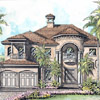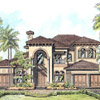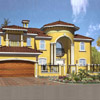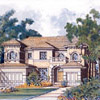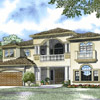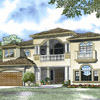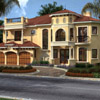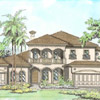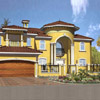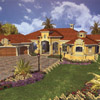The creditors' committee for Hollywood home builder Tousa is taking aim at another group of defendants in their so-far successful lawsuits stemming from claims that a bail out and refinancing in mid-2007 of a joint venture in Transeastern Properties resulted in fraudulent transfers.
The committee already won judgment against secured lenders on claims that loans made six months before the Chapter 11 filing were fraudulent transfers. The bankruptcy judge required the lenders to post a total of $700 million in appeal bonds to stay enforcement of his October ruling that the transactions were voidable in bankruptcy.
The committee, in papers filed last week, wants authority from the bankruptcy court to sue another group of defendants to recover an additional $60 million in payments made during the Transeastern bailout.
The committee, if permitted, will sue for $50 million from Arthur and Edward Falcone, who were owners of the company that was Tousa's joint venturer in buying Transeastern in 2005. The committee says money given the Falcones and their companies in mid-2007 were fraudulent transfers.
The committee also wants the right to sue Kendall Land Development LLP, which also received payments as part of the settlement in mid-2007 regarding Transeastern.
Tousa filed for bankruptcy reorganization in January 2008. The company listed assets of $2.1 billion against debt totaling $2 billion. At the outset of the reorganization it was 67 percent-owned by Technical Olympic SA.
Tuesday, December 29, 2009
Tuesday, December 22, 2009
Exterior Remodeling Proves Best Bang for Your Buck, Realtors(R) Report
Despite a slow market and a slight decrease in the resale value of most remodeling projects, Realtors® report that the smartest home improvement investments may also be some of the least expensive. Results from the "2009 Remodeling Cost vs. Value Report" show that small-scale exterior projects are the most profitable at resale, according to estimates by Realtors® who completed a recent survey.
On a national level, eight out of the top 10 projects in terms of costs recouped were exterior replacement projects that cost less than $14,000. Certain types of door and siding replacements, as well as wood deck additions all returned more than 80 percent of project costs upon resale. A steel entry door replacement -- a new addition to this year's list -- recouped 128.9 percent of costs, followed by upscale fiber-cement sliding replacements at 83.6 percent. Wood deck additions recouped 80.6 percent of costs.
"Once again, this year's 'Remodeling Cost vs. Value Report' highlights the importance of a home's first impression," said NAR President Vicki Cox Golder, owner of Vicki L. Cox & Associates in Tucson, Ariz. "With exterior projects returning a high percent of project costs upon resale, Realtors® can help give your home curb appeal while adding value to the real estate transaction."
The "2009 Remodeling Cost vs. Value Report" compares construction costs with resale values for 33 midrange and upscale remodeling projects comprising additions, remodels and replacements in 80 markets across the country. Data are grouped in nine U.S. regions, following the divisions established by the U.S. Census Bureau. This is the 12th consecutive year that the report, which is produced by Hanley Wood, LLC, was completed in cooperation with REALTOR® Magazine, as Realtors® provided their insight into local markets and buyer home preferences within those markets.
On a national level, the project with the biggest improvement from 2008 was the attic bedroom addition, recouping 83.1 percent of remodeling costs compared to 73.8 percent in 2008. The only other interior project that landed in the top 10 was a minor kitchen remodel with 78.3 percent costs recouped.
Other exterior projects in the top 10 include midrange vinyl and upscale foam-backed vinyl sliding replacements, which returned more than 79 percent of costs. In addition, several types of window replacements -- midrange wood, midrange vinyl, and upscale vinyl -- all returned more than 76 percent of costs upon sale.
Similar to last year's report, the least profitable remodeling projects in terms of resale value were home office remodels and sunroom additions, returning only 48.1 percent and 50.7 percent of project costs.
Regionally, cities in the Pacific states of Alaska, California, Hawaii, Oregon and Washington once again outperformed the rest of the nation in terms of remodeling costs recouped upon resale. The West South Central region of Arkansas, Louisiana, Oklahoma, and Texas; the East South Central region of Alabama, Kentucky, Mississippi and Tennessee; and the South Atlantic region of the District of Columbia, Florida, Georgia, Maryland, North Carolina, South Carolina, Virginia and West Virginia also performed relatively well.
The regions that generally returned the lowest percentage of costs were New England (Connecticut, Massachusetts, Maine, New Hampshire, Rhode Island and Vermont), East North Central (Illinois, Indiana, Michigan, Ohio and Wisconsin), West North Central (Iowa, Kansas, Minnesota, Missouri, Nebraska, North Dakota and South Dakota), and the Middle Atlantic (New York and Pennsylvania).
Golder commented that remodeling projects are just one of many factors that contribute to a home's overall resale value. "As the first, best source for real estate information, Realtors® are experts in providing insight into what projects and investments will make a difference in your house. It's important to consult with a Realtor® who can explain the variety of factors that affect a home's value, such as location, condition of surrounding properties and the regional economic climate," she said.
Results of the report are summarized in the January issue of REALTOR® Magazine. To read the full project descriptions, access national and regional project data, and download a free PDF containing data for any of the 80 cities covered by the report, visit www.costvsvalue.com. "Cost vs. Value" is a registered trademark of Hanley Wood, LLC.
Hanley Wood, LLC, is the premier media company serving housing and construction. Through four operating divisions, the company produces award-winning magazines and Web sites, marquee trade shows and events, rich data, and custom marketing solutions. The company also is North America's leading provider of home plans. Founded in 1976, Hanley Wood is a $240 million company owned by JPMorgan Partners, LLC, a private equity affiliate of JPMorgan Chase & Co.
The National Association of Realtors®, "The Voice for Real Estate," is America's largest trade association, representing 1.2 million members involved in all aspects of the residential and commercial real estate industries.
Information about NAR is available at www.realtor.org. This and other news releases are posted in the News Media section. Statistical data, charts and surveys also may be found by clicking on Research.
REALTOR® is a registered collective membership mark which may be used only by real estate professionals who are members of the NATIONAL ASSOCIATION OF REALTORS® and subscribe to its strict Code of Ethics. Not all real estate agents are REALTORS®. All REALTORS® are members of NAR.
On a national level, eight out of the top 10 projects in terms of costs recouped were exterior replacement projects that cost less than $14,000. Certain types of door and siding replacements, as well as wood deck additions all returned more than 80 percent of project costs upon resale. A steel entry door replacement -- a new addition to this year's list -- recouped 128.9 percent of costs, followed by upscale fiber-cement sliding replacements at 83.6 percent. Wood deck additions recouped 80.6 percent of costs.
"Once again, this year's 'Remodeling Cost vs. Value Report' highlights the importance of a home's first impression," said NAR President Vicki Cox Golder, owner of Vicki L. Cox & Associates in Tucson, Ariz. "With exterior projects returning a high percent of project costs upon resale, Realtors® can help give your home curb appeal while adding value to the real estate transaction."
The "2009 Remodeling Cost vs. Value Report" compares construction costs with resale values for 33 midrange and upscale remodeling projects comprising additions, remodels and replacements in 80 markets across the country. Data are grouped in nine U.S. regions, following the divisions established by the U.S. Census Bureau. This is the 12th consecutive year that the report, which is produced by Hanley Wood, LLC, was completed in cooperation with REALTOR® Magazine, as Realtors® provided their insight into local markets and buyer home preferences within those markets.
On a national level, the project with the biggest improvement from 2008 was the attic bedroom addition, recouping 83.1 percent of remodeling costs compared to 73.8 percent in 2008. The only other interior project that landed in the top 10 was a minor kitchen remodel with 78.3 percent costs recouped.
Other exterior projects in the top 10 include midrange vinyl and upscale foam-backed vinyl sliding replacements, which returned more than 79 percent of costs. In addition, several types of window replacements -- midrange wood, midrange vinyl, and upscale vinyl -- all returned more than 76 percent of costs upon sale.
Similar to last year's report, the least profitable remodeling projects in terms of resale value were home office remodels and sunroom additions, returning only 48.1 percent and 50.7 percent of project costs.
Regionally, cities in the Pacific states of Alaska, California, Hawaii, Oregon and Washington once again outperformed the rest of the nation in terms of remodeling costs recouped upon resale. The West South Central region of Arkansas, Louisiana, Oklahoma, and Texas; the East South Central region of Alabama, Kentucky, Mississippi and Tennessee; and the South Atlantic region of the District of Columbia, Florida, Georgia, Maryland, North Carolina, South Carolina, Virginia and West Virginia also performed relatively well.
The regions that generally returned the lowest percentage of costs were New England (Connecticut, Massachusetts, Maine, New Hampshire, Rhode Island and Vermont), East North Central (Illinois, Indiana, Michigan, Ohio and Wisconsin), West North Central (Iowa, Kansas, Minnesota, Missouri, Nebraska, North Dakota and South Dakota), and the Middle Atlantic (New York and Pennsylvania).
Golder commented that remodeling projects are just one of many factors that contribute to a home's overall resale value. "As the first, best source for real estate information, Realtors® are experts in providing insight into what projects and investments will make a difference in your house. It's important to consult with a Realtor® who can explain the variety of factors that affect a home's value, such as location, condition of surrounding properties and the regional economic climate," she said.
Results of the report are summarized in the January issue of REALTOR® Magazine. To read the full project descriptions, access national and regional project data, and download a free PDF containing data for any of the 80 cities covered by the report, visit www.costvsvalue.com. "Cost vs. Value" is a registered trademark of Hanley Wood, LLC.
Hanley Wood, LLC, is the premier media company serving housing and construction. Through four operating divisions, the company produces award-winning magazines and Web sites, marquee trade shows and events, rich data, and custom marketing solutions. The company also is North America's leading provider of home plans. Founded in 1976, Hanley Wood is a $240 million company owned by JPMorgan Partners, LLC, a private equity affiliate of JPMorgan Chase & Co.
The National Association of Realtors®, "The Voice for Real Estate," is America's largest trade association, representing 1.2 million members involved in all aspects of the residential and commercial real estate industries.
Information about NAR is available at www.realtor.org. This and other news releases are posted in the News Media section. Statistical data, charts and surveys also may be found by clicking on Research.
REALTOR® is a registered collective membership mark which may be used only by real estate professionals who are members of the NATIONAL ASSOCIATION OF REALTORS® and subscribe to its strict Code of Ethics. Not all real estate agents are REALTORS®. All REALTORS® are members of NAR.
Thursday, December 17, 2009
Home Improvement Tips
If you're planning to remodel, you are invited to ask questions and take advantage of the resources on www.continuous-home-
Monday, December 14, 2009
Home Building Review for 2009
2009 will go down in history as the worst year for housing production since World War II, when the nation purposely diverted resources from building homes toward the war effort. But builders may remember 2009 as much for events stemming from unprecedented government efforts to prop up housing starts and homeowner efforts to fight off the pernicious forces of unemployment and foreclosure.
Optimists among us may also remember 2009 as a year of rebirth. After hitting bottom during the winter months, and sending economists to dust off old stats in an attempt to figure out when times were last this bad, new home starts and sales steadily recovered throughout the year. From January through October, housing starts were on a steady march, increasing 31 percent, a rate that most housing economists expect to accelerate next year.
Much of the increased activity probably would not have happened without a series of government initiatives. Though officially announced in 2008, the Federal Reserve Board bought hundreds of billions of mortgage-backed securities throughout the year to keep up a flow of mortgage money. As lenders hemorrhaged red ink, the FHA and other government agencies stepped up big time to insure or write mortgages on half the new homes sold in this country, by some estimates.
Moreover, Congress replaced a largely ineffective, $7,500 loan program for home buyers with an $8,000 tax credit for first-time buyers that was available through November. The tax credit worked some magic, stimulating sales throughout the country. Home building slowed, though, once time ran out to qualify for the credit. Thankfully, lawmakers extended the credit through April 2010 for signed contracts and created a new $6,500 credit for repeat buyers to boot.
Despite the government's efforts, 2009 was a year of great hardship. Unemployment rose to 10.2% as companies downsized. A record number of households lost their homes to foreclosure, despite government and bank efforts to stem the tide. And an unusual out-of-court agreement between one politician and the secondary mortgage market giants resulted in a new appraisal system that gave builders fits.
Negative economic forces accelerated the stress in the home building ranks, busting dozens of former leading players. A growing number of builders that had once completed 100 or more homes a year filed for bankruptcy, liquidated, or simply closed their doors. Bankruptcies grew even though after three years of housing recession far fewer builders were around to go under.
Given how many important events shaped home building this year, it wasn't easy. The inability to complete The New American Home 2010 due to financing difficulties, an event that drew national media attention, didn't make the list. Neither did a crisis over Chinese drywall that surfaced last spring and built monthly in intensity.
By: Boyce Thompson
Much of the increased activity probably would not have happened without a series of government initiatives. Though officially announced in 2008, the Federal Reserve Board bought hundreds of billions of mortgage-backed securities throughout the year to keep up a flow of mortgage money. As lenders hemorrhaged red ink, the FHA and other government agencies stepped up big time to insure or write mortgages on half the new homes sold in this country, by some estimates.
Moreover, Congress replaced a largely ineffective, $7,500 loan program for home buyers with an $8,000 tax credit for first-time buyers that was available through November. The tax credit worked some magic, stimulating sales throughout the country. Home building slowed, though, once time ran out to qualify for the credit. Thankfully, lawmakers extended the credit through April 2010 for signed contracts and created a new $6,500 credit for repeat buyers to boot.
Despite the government's efforts, 2009 was a year of great hardship. Unemployment rose to 10.2% as companies downsized. A record number of households lost their homes to foreclosure, despite government and bank efforts to stem the tide. And an unusual out-of-court agreement between one politician and the secondary mortgage market giants resulted in a new appraisal system that gave builders fits.
Negative economic forces accelerated the stress in the home building ranks, busting dozens of former leading players. A growing number of builders that had once completed 100 or more homes a year filed for bankruptcy, liquidated, or simply closed their doors. Bankruptcies grew even though after three years of housing recession far fewer builders were around to go under.
Given how many important events shaped home building this year, it wasn't easy. The inability to complete The New American Home 2010 due to financing difficulties, an event that drew national media attention, didn't make the list. Neither did a crisis over Chinese drywall that surfaced last spring and built monthly in intensity.
By: Boyce Thompson
Tuesday, December 8, 2009
Featured Home Plans by Aronson Architects
Come look at home plans that range from 1,000 sq.ft. and single story to two-story homes that exceed 5,500 sq.ft. Your next home design is just a click away.
Labels:
1000 sq.ft.,
5500 sq.ft.,
floor plans,
home plans,
house plans
Friday, December 4, 2009
Most Desirable House Plan Features
Most Desirable House Plan Features
Your house is more than a place to call home. It is an investment in your family's future. Liken it to investing in the stock market. A bad decision in the stock market can cost you tons of money if you chose the wrong stock to invest in. The same is true if you chose the wrong house floor plan. It may look appealing in its presentation but, will it attract buyers once it is built? If the floor plan design includes the things most desired by a buying population, then the answer is absolutely!House floor plans lay the foundation for a value packed home by including trends of today and being adaptable for future needs. When chosing from the thousands of plans out on the web or working with a designer on your custom home, include features in your floor plans that are not so unique to your style. Rather, consider the needs of potential future home buyers in your decision to ensure a healthy investment in your homes financial future.
Below are the features most desired by home buyers. Most house plans may not have all these features; however, the more you have included the better.
1. Spacious kitchen with plenty of storage - Women especially hone in on this area of the home. The floor plan should indicate plenty of counter space to work on. Cabinets are also very important for use in storage. The kitchen Space planning should allow two cooks to work together without feeling conjested. Pantry's are also a must.
2. Keeping rooms - This space is desired in larger homes with the available square footage. This room is more of a mid size family room adjoining the kitchen and breakfast rooms. For homes with 2 two story grand rooms and large family rooms, the keeping room provides a cozy spot for the family's day to day activities.
3. Master bedroom with a sitting area - Perhaps the one space the shares the top spot with the kitchen. The master bedroom should have enough space to accommodate a queen or king size bed with room to spare. The sitting area is a bonus within the master retreat allowing a space for at minimum a couple of chairs and an end table. A more elaborant sitting room has a fireplace with shelving and place for a television.
4. Master bath - Must have separate vanity's, tub, and shower, design to be open and bright with plenty of natural light. If the budget allows, a his and hers bath is an excellent upgrade. It should provide dual vanities, dual water closets, a shower for him with access for her and a tub for her.
5. His and hers closet - The bigger the better, especially for the woman of the house! While a single enormous closet is a nice feature, seperate closets are much more desirable. In addition, upgrading the closets with a closet organizing system is truely a good investment.
6. Bedroom on the main floor (applicable in 2 story home designs) - If the master is on the main floor, this is fine. A guest bed in addition to the master on the main is even better. However, if all bedrooms are on the second floor, adding a guest bed on the main floor is a wise choice. It can serve multiple needs in addition to lodging for overnight guest. Other uses could be a library or home office.
7. Mudroom - One of the most requested features. Provides the homeowner a place to use as a buffer between the outdoors and the homes interior. The mudroom serves as a docking area to drop off keys, jackets & coats, dirty shoes, umbrellas, and other nic-nak items without dragging these things into the main part of the home.
8. Bonus room - If the floor plan design allows for this, by all means, include this space. Bonus rooms are the wildcard's, giving homeowners the ability to personalize this room to their liking, starting from a clean slate.
9. Covered entrance - More and more homeowners are trending towards some sort of covered porch or covered stoop to provide shelter from weather conditions at the homes main entrance. Most come to this conclusion after living in a home that lacked this featured.
10. Storage - Need I say more! You can never have enough.
Combining the above design features in addition to the normal plan features (i.e. bedrooms, living, dining, family or keeping room), will afford you the best return on your house floor plan selection when its time to cash in on your nest egg!




